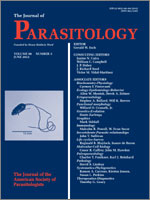The ultrastructure of the spores and developmental stages of Ellipsomyxa mugilis in Nereis diversicolor were studied by transmission electron microscopy. The ultrastructure features and the developmental stages show many similarities with the general pattern described for other actinospores. However, several new features are definitely worth noting. For example, tetranucleated cells precede the formation of the initial pansporocyst, which preserves the 2 original enveloping cells until the end of sporogony. In the initial stages of sporogony, the future sporoplasm cell acquires the first secondary cell by an engulfment process. In the final stage of sporogony, spores are formed by a sporoplasm with 2 secondary cells and 1 somatic nucleus, and the polar capsule has a polar filament with a helicoidal arrangement possessing 7–8 coils.
How to translate text using browser tools
1 June 2012
Ultrastructural Aspects of Ellipsomyxa mugilis (Myxozoa: Ceratomyxidae) Spores and Developmental Stages In Nereis diversicolor (Polychaeta: Nereidae)
Luis Filipe Rangel,
Carlos Azevedo,
Graça Casal,
Maria João Santos
ACCESS THE FULL ARTICLE

Journal of Parasitology
Vol. 98 • No. 3
June 2012
Vol. 98 • No. 3
June 2012




